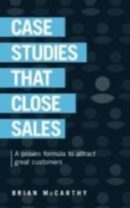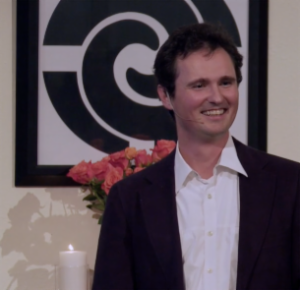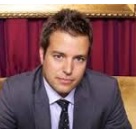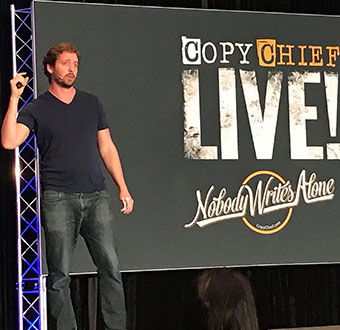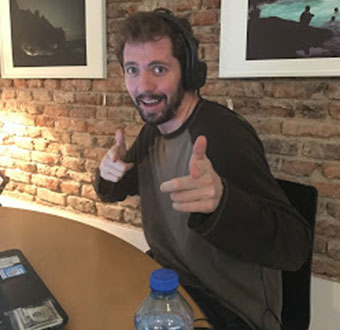Once again, DDP Yoga created a case study that went crazy viral.
This time, it’s a man who lost nearly 200lbs in a year.
Let’s break this sucker down to see what made it successful:
1. The setup
The opening of this case study shows the guy, Vance, on his couch, talking into his phone.
This does two things: First, it paints the “before” picture. You see what he looks like and learn how much he weighs.
Second, they dive right into what screenwriters call the inciting incident. This is the thing that happens to set the story in motion.
In Lord of the Rings, it’s when they realize the ring is evil AF and needs to burn in a pit of doom.
In The Big Lebowski, it’s when thugs break into his house and pee on the rug.
In this story, it’s when Vance sees someone else’s weight loss journey. Vance shares how this gave him the determination to make a change.
2. The Pursuit
Vance’s first attempt at weight loss is to start walking every day with friends.
They include the picture of him walking with those friends to give you that “warm-and-fuzzy” feeling. It feels good to see he has support. And more importantly, that’s the kind of support the viewer wants.
They want friends and family by their side. They don’t want to feel they have to do it alone. Adding this image shows how good it can feel and how supported they can be if they go on the same journey.
It also shows this is a real story with real people. People are wary of things they see online. So bringing other people into it and showing real pictures helps viewers see that this is a true story.
3 — The Emotional Rollercoaster
Right as you start feeling all warm and fuzzy, the video smacks you in the face.
They show that his walks he’s been taking haven’t helped. And he actually gained weight.
From there, they show how he kept at it. They show how his support grew (more stuff to hit ya right in the feels.) Then they share his excitement over seeing that first bit of weight loss.
What they’re doing is going back and forth between emotional highs and emotional lows. Every struggle is followed by a success. Every success is followed by a downfall.
He went from being excited to losing weight, to feeling down because he wasn’t getting results, to being happy once the weight loss started.
This up-and-down emotional journey keeps the story compelling.
You see this in every good fiction book, TV show or movie. If a scene starts on a high note (everyone getting along) it’ll inevitably end in a fight. If it starts with a fight it’ll end in hugs.
One of my favorite shows that always does this is Billions. The moment Axelrod is on top and thinks he’s in the clear, Chuck Rhodes does something to bring it all crashing down. And visa versa.
4 “I like this guy”
Around the 1:40 mark there are clips of Vance talking. He’s excited about his success so far and recaps his journey.
In these clips, the dude is just so god damn charming. He’s got that “aw shucks” southern drawl. You see the genuine surprise and excitement in having a bit of success. So you really start to like the guy, see how real he is, and start rooting for him.
5 — Selling without being salesy
This is a story about a guy who lost 200lbs using DDP Yoga. Here we are 2 minutes into a 5-minute video and this is the first we hear about Diamond Dallas Page and his yoga program.
This is super important. They wait until you’re sucked into the story to even hint at the fact that maybe this is an ad. And they do it in a super subtle way — just saying DDP reached out and he started using the program.
They don’t beat you over the head with who DDP is or why his method is so great. They simply introduce him as the guy who came in to help. Then let the rest of Vance’s story do the talking.
Unlike other marketers who beat you over the head with how great they/their product is, they simply sit back and show you.
6 — The Struggle
This is my favorite part of the whole thing. Because they brilliantly do what so many case studies overlook — they show the struggle and doubt Vance experienced while using the program.
Most case studies are all:
“Then I bought this thing and OMG my life got amazing! Look at me on this yacht with super models! Last night I farted and a rainbow shot from my butt all the way to Kansas! This is the best!”
Instead, this add highlights the fact that this wasn’t a “mircale product.”
There were challenges. It wasn’t easy. Vance still had doubts.
Doing this makes it more real — and not feel like fluffly marketing.
It also keeps the story about Vance. He is the hero — not the DDP method. That’s just the tool that helped him along the way.
By making it more about Vance and his struggle the story continues to be relatable. And people can still see themselves in him. If you take the struggle away, that connection disappears. The viewer has more room to doubt that this can work for them. Because struggle is where the connection is.
7 — Success montage
Remember the emotional rollercoaster we talked about?
Welp, after the struggle it’s time to fly back up with a little success montage.
Here they point out the different milestones Vance reached: Losing 8lbs, 11lbs, 5lbs…
As exciting as this is, just hearing data on weight loss isn’t super emotionally compelling.
So they hit you in the feels by once again showing the group Vance walked with and how that grew.
This is subtle but huge. They are making this about more than just losing weight. It’s about community, friendship, and people coming together to support one another.
Again, all great stories do this.
Harry Potter isn’t about the end result of *SPOILER* defeating Voldemort. It’s about people coming together and having each other’s backs.
The Fast and Furious franchise isn’t just about nice cars smashing into things. It’s about barbecuing on a Sunday afternoon with people you care about.
By showing the community they make this about more than just numbers on a scale. It adds that emotional weight that gets viewers excited and teary-eyed.
8 – Hitting the deeper desires
I’ve written case studies for people who have lost massive amounts of weight. And one of the primary motivations they all stated was they wanted to inspire others — particularly their family.
Welp, around 3:50 they show Vance achieving this goal. He’s up on stage. People are celebrating his accomplishment and talking about how inspiring his story is.
To people watching, that’s what they want.
They want to lose the weight and be the person others look to for inspiration.
9 — His new life
One year later, Vance meets Diamond Dallas Page.
Doing this at the end shows the contrast in how his life has changed.
He went from sitting on the couch, super overweight with nothing but a dream to get thinner… to now being 200lbs lighter with people celebrating his achievement.
You want to give people a clear image in their mind of what success with your product will look like. If they can see it, they can believe it. And this is a pretty darn good one.
10 — Recap
After the story, there’s a quick recap to make sure you didn’t miss the point — saying he lost 198lbs in a year.
Don’t think people will get the point on their own. You’ve got to drive it home for them. Tell them what you told them.
11 — Inspiration -> Going viral on cold traffic
The last thing they do is awesome.
They’re not like “see how great DDP yoga is!” — which is what every other marketer would do.
Instead, they leave you with an inspiring, uplifting message.
They say:
If you knew success was a certainty, what would you attempt to do?
Then they tell you to Be Unstoppable.
This plays a big role in why this went viral.
People love to share positive, uplifting messages.
Just look on Instagram. It’s littered with “feel good” quotes.
They keep the focus on inspiring the viewer and helping them feel empowered. So people want to share the story in order to help others feel great.
3 Ways to make the ad even better
This video is damn near perfect. But there are a few things that could be added to get even more emotion and more people responding.
1. Go into more detail on what this weight loss means for him.
Have him share how his life is different. How does he feel now? What positive experiences are available to him that weren’t there before?
Doing this can ramp up the emotion and create more desire for the viewer to get the same results.
2. Add a CTA.
I’d be careful not to make it sound too much like a pitch because that would ruin the whole “inspiring message” ending that helped it go viral.
But still, having a clear CTA can help you get action out of people who otherwise wouldn’t do anything.
For example, tell them to share the story if they were moved by it. Or add something as simple as “To see more inspiring stories go to the “DDPYoga.com.”
3. Go into more detail (preferably early on) on the pain of being that overweight.
Why was it so important for him to do lose the weight?
Having Vance answer this question can help the reader tap into their own pain around weight loss.
People buy to both avoid pain and get pleasure. So you want to make sure both things are covered in your case study. That way they are as motivated as can be to learn more about you/your program.
Speaking of CTA, maybe you should scroll up and get my free Ultimate Guide to Case studies. That way you’ll be on my email list and I can send you more articles like this — plus random fun stuff that can make you giggle next time you’re on the toilet reading email.

